Structure and Properties of Arc Ion Plating Deposited AlCrSiN Coatings Controlled by Pulsed Bias Voltage
Abstract
1. Introduction
2. Materials and Methods
2.1. Coating Deposition
2.2. Characterization of Coatings
3. Results
3.1. Chemical Composition and Phase Analysis
3.2. Morphologies
3.3. Microhardness and Critical Load
3.4. Tribological Properties
3.5. Electrochemical Properties
4. Conclusions
- (1)
- With the increase pulsed bias, the quantity and size of microparticles on the resulting AlCrSiN coatings first decreased and then increased, and reaching the minimum value as the bias voltage was −100 V.
- (2)
- With the increase in pulsed bias, the hardness, critical load, and wear resistance of the AlCrSiN coatings first increased and then decreased, and reached the maximum values as the bias voltage was −100 V. In this case, the coating hardness and critical load were 2668 HV and 72.7 N, respectively.
- (3)
- With the increase in the pulsed bias, the friction coefficient and wear rate of the AlCrSiN coatings first decreased and then increased. As the bias voltage was −100 V, the resulted coating presented the best tribological performance. The average friction coefficient and wear rate were 0.35 and 1.02 × 10−3 μm3/N·μm, respectively.
- (4)
- The AlCrSiN coatings significantly enhanced the corrosion resistance of 304 stainless steel, indicating that the AlCrSiN coating is a promising protective barrier in environments containing aggressive chloride ions.
Author Contributions
Funding
Informed Consent Statement
Data Availability Statement
Conflicts of Interest
References
- Jäger, N.; Meindlhumer, M.; Zitek, M.; Spor, S.; Hruby, H.; Nahif, F.; Julin, J.; Rosenthal, M.; Keckes, J.; Mitterer, C.; et al. Impact of Si on the high-temperature oxidation of AlCr(Si)N coatings. J. Mater. Sci. Technol. 2022, 100, 91–100. [Google Scholar] [CrossRef]
- Liang, J.; Almandoz, E.; Ortiz-Membrado, L.; Rodríguez, R.; de Ara, J.F.; Fuentes, G.G.; Jiménez-Piqué, E. Mechanical Performance of AlCrSiN and AlTiSiN Coatings on Inconel and Steel Substrates after Thermal Treatments. Materials 2022, 15, 8605. [Google Scholar] [CrossRef] [PubMed]
- Wang, T.G.; Jeong, D.; Liu, Y.M.; Wang, Q.M.; Iyengar, S.; Melin, S.; Kim, K.H. Study on nanocrystalline Cr2O3 films deposited by arc ion plating: II. Mechanical and tribological properties. Surf. Coat. Technol. 2012, 206, 2638–2644. [Google Scholar] [CrossRef]
- Zubizarreta, C.; Hernández, O.; Fernández-Martínez, I.; Ciarsolo, I.; Díez-Sierra, J.; Carreras, L.; Barriga, J. The effect of Bias configuration on the properties of AlCrN based thick coatings deposited by Cathodic Arc Evaporation. Appl. Surf. Sci. 2023, 610, 155543. [Google Scholar] [CrossRef]
- Zhang, S.H.; Wang, L.; Wang, Q.M.; Li, M.X. A superhard CrAlSiN superlattice coating deposited by multi-arc ion plating: I. Microstructure and mechanical properties. Surf. Coat. Technol. 2013, 214, 160–167. [Google Scholar] [CrossRef]
- Li, J.L.; Tan, C.B.; Luo, X.Y.; Xie, Z.J.; Zhong, X.L.; Wang, J.B.; Song, H.J. Preparation and toughness optimization of (AlCrSiN/TiN)20/Ti multilayer multiscale bionic tool coatings. Appl. Surf. Sci. 2023, 634, 157585. [Google Scholar] [CrossRef]
- Li, B.S.; Wang, T.G.; Ding, J.C.; Cai, Y.J.; Shi, J.; Zhang, X.T. Influence of N2/Ar flow ratio on microstructure and properties of the AlCrSiN coatings deposited by high-power impulse magnetron sputtering. Coatings 2017, 8, 3. [Google Scholar] [CrossRef]
- Gao, Y.; Cai, F.; Lu, X.; Xu, W.; Zhang, C.; Zhang, J.Z.; Qu, X.H. Design of cycle structure on microstructure, mechanical properties and tribology behavior of AlCrN/AlCrSiN coatings. Ceram. Int. 2022, 48, 12255–12270. [Google Scholar] [CrossRef]
- Li, M.; Yu, Y.J.; Zou, C.W.; Tian, C.X.; Wang, Z.S.; Xiang, Y.X. Wear and Corrosion Resistance of CrYN Coating in Artificial Seawater. Metals 2023, 13, 183. [Google Scholar] [CrossRef]
- Fan, Q.X.; Zhang, S.; Ma, D.Z.; Wu, Z.H.; Cao, F.T.; Liu, Y.M.; Wang, T.G. Bias voltage optimization and cutting performance of AlCrN coatings deposited by a hybrid technology. Vacuum 2022, 204, 111348. [Google Scholar] [CrossRef]
- Cai, F.; Gao, Y.; Fang, W.; Mao, T.J.; Zhang, S.H.; Wang, Q.M. Improved adhesion and cutting performance of AlTiSiN coatings by tuning substrate bias voltage combined with Ar ion cleaning pre-treatment. Ceram. Int. 2018, 44, 18894–18902. [Google Scholar] [CrossRef]
- Tang, J.F.; Lin, C.Y.; Yang, F.C.; Chang, C.L. Influence of nitrogen content and bias voltage on residual stress and the tribological and mechanical properties of CrAlN films. Coatings 2020, 10, 546. [Google Scholar] [CrossRef]
- Salamania, J.; Johnson, L.J.S.; Schramm, I.C.; Calamba, K.M.; Boyd, R.; Bakhit, B.; Odén, M. Influence of pulsed-substrate bias duty cycle on the microstructure and defects of cathodic arc-deposited Ti1-xAlxN coatings. Surf. Coat. Technol. 2021, 419, 127295. [Google Scholar] [CrossRef]
- Kang, M.S.; Wang, T.G.; Shin, J.H.; Nowak, R.; Kim, K.H. Synthesis and properties of Cr–Al–Si–N films deposited by hybrid coating system with high power impulse magnetron sputtering (HIPIMS) and DC pulse sputtering. Trans. Nonferrous Met. Soc. China 2012, 22, s729–s734. [Google Scholar] [CrossRef]
- Liang, J.; Serra, M.; Gordon, S.; de Ara, J.F.; Almandoz, E.; Llanes, L.; Jimenez-Piqué, E. Comparative Study of Mechanical Performance of AlCrSiN Coating Deposited on WC-Co and cBN Hard Substrates. Ceram. Int. 2023, 6, 1238–1250. [Google Scholar] [CrossRef]
- Petkov, N.; Bakalova, T.; Bahchedzhiev, H.; Kejzlar, P.; Rysanek, P.; Kormunda, M.; Capkova, P. Influence of the Addition of the Elements Ti and Cr on the Structure, and Mechanical and Tribological Properties of AlSiN Coatings. J. Nano Res. 2022, 73, 175–196. [Google Scholar] [CrossRef]
- Wang, T.G.; Jeong, D.; Kim, S.H.; Wang, Q.; Shin, D.W.; Melin, S.; Kim, K.H. Study on nanocrystalline Cr2O3 films deposited by arc ion plating: I. composition, morphology, and microstructure analysis. Surf. Coat. Technol. 2012, 206, 2629–2637. [Google Scholar] [CrossRef]
- Chen, Y.; Xu, Y.X.; Zhang, H.Q.; Wang, Q.M.; Wei, T.F.; Zhang, F.G.; Kim, K.H. Improving high-temperature wear resistance of arc-evaporated AlCrN coatings by Mo alloying. Surf. Coat. Technol. 2023, 456, 129253. [Google Scholar] [CrossRef]
- Jao, J.Y.; Han, S.; Chang, L.S.; Chang, C.L.; Liu, Y.C.; Shih, H.C. Bias voltage effect on the structure and property of chromium copper-diamond-like carbon multilayer films fabricated by cathodic arc plasma. Appl. Surf. Sci. 2010, 256, 7490–7495. [Google Scholar] [CrossRef]
- Qiu, Y.X.; Zhang, S.; Lee, J.W.; Li, B.; Wang, Y.X.; Zhao, D.L.; Sun, D. Towards hard yet self-lubricious CrAlSiN coatings. J. Alloys Compd. 2015, 618, 132–138. [Google Scholar] [CrossRef]
- Pribytkov, G.; Korzhova, V.; Korosteleva, E.; Krinitcyn, M. Effect of Silicon on the Surface Modification of Al-Cr Powder Cathodes Subjected to Vacuum Arc Treatment. Coatings 2022, 12, 958. [Google Scholar] [CrossRef]
- Zou, Z.M.; Dai, S.X.; Wang, R.D.; Li, Y.H.; Li, P.; Ge, F.F. Improvement of the high-temperature steam oxidation resistance of Zirlo tubes by multilayer Cr/CrAlSiN coatings. Surf. Coat. Technol. 2023, 466, 129616. [Google Scholar] [CrossRef]
- Luo, Y.; Dong, Y.Y.; Xiao, C.; Wang, X.T.; Peng, H. Impact Abrasive Wear Property of CrAlN/TiSiN Multilayer Coating at Elevated Temperatures. Materials 2022, 15, 2214. [Google Scholar] [CrossRef]
- Ahlgren, M.; Blomqvist, H. Influence of bias variation on residual stress and texture in TiAlN PVD coatings. Surf. Coat. Technol. 2005, 200, 157–160. [Google Scholar] [CrossRef]
- Cai, F.; Zhang, S.H.; Li, J.L.; Chen, Z.; Li, M.X.; Wang, L. Effect of nitrogen partial pressure on Al–Ti–N films deposited by arc ion plating. Appl. Surf. Sci. 2011, 258, 1819–1825. [Google Scholar] [CrossRef]
- Gong, H.X.; Huang, J.; Wang, J.J.; Zhao, P.B.; Liang, C.Y.; Guo, W.; Cao, R.Q.; Bai, D.Q. Research on the printing mechanism of electrohydrodynamic satellite-free droplets in pulsed voltage. J. Manuf. Process. 2023, 101, 300–310. [Google Scholar] [CrossRef]
- Cai, F.; Chen, M.H.; Li, M.X.; Zhang, S.H. Influence of negative bias voltage on microstructure and property of Al–Ti–N films deposited by multi-arc ion plating. Ceram. Int. 2017, 43, 3774–3783. [Google Scholar] [CrossRef]
- Polcar, T.; Cavaleiro, A. High-temperature tribological properties of CrAlN, CrAlSiN and AlCrSiN coatings. Surf. Coat. Technol. 2011, 206, 1244–1251. [Google Scholar] [CrossRef]
- Hsu, C.H.; Lin, C.Y.; Chen, J.X. Wear and Corrosion Performance of Ti-6Al-4V Alloy Arc-Coated TiN/CrN Nano-Multilayer Film. Metals 2023, 13, 907. [Google Scholar] [CrossRef]
- Wang, T.G.; Dong, Y.; Gebrekidan, B.A.; Liu, Y.M.; Fan, Q.X.; Kim, K.H. Microstructure and properties of the Cr–Si–N coatings deposited by combining high-power impulse magnetron sputtering (HiPIMS) and pulsed DC magnetron sputtering. Acta Met. Sin. 2017, 30, 688–696. [Google Scholar] [CrossRef]
- Sidashov, A.V.; Boiko, M.V.; Kozakov, A.T.; Manturov, D.S. Properties of CrAlSiN Coatings: Spectroscopic Research. Russ. Eng. Res. 2022, 42, 477–481. [Google Scholar] [CrossRef]
- Wang, T.G.; Zhao, S.S.; Hua, W.G.; Gong, J.; Sun, C. Design of a separation device used in detonation gun spraying system and its effects on the performance of WC-Co coatings. Surf. Coat. Technol. 2009, 203, 1637–1644. [Google Scholar] [CrossRef]
- Ghaziof, S.; Kilmartin, P.A.; Gao, W. Electrochemical studies of sol-enhanced Zn–Ni–Al2O3 composite and Zn–Ni alloy coatings. J. Electroanal. Chem. 2015, 755, 63–70. [Google Scholar] [CrossRef]
- Moshtaghi, M.; Safyari, M.; Mori, G. Hydrogen absorption rate and hydrogen diffusion in a ferritic steel coated with a micro-or nanostructured ZnNi coating. Electrochem. Commun. 2022, 134, 107169. [Google Scholar] [CrossRef]
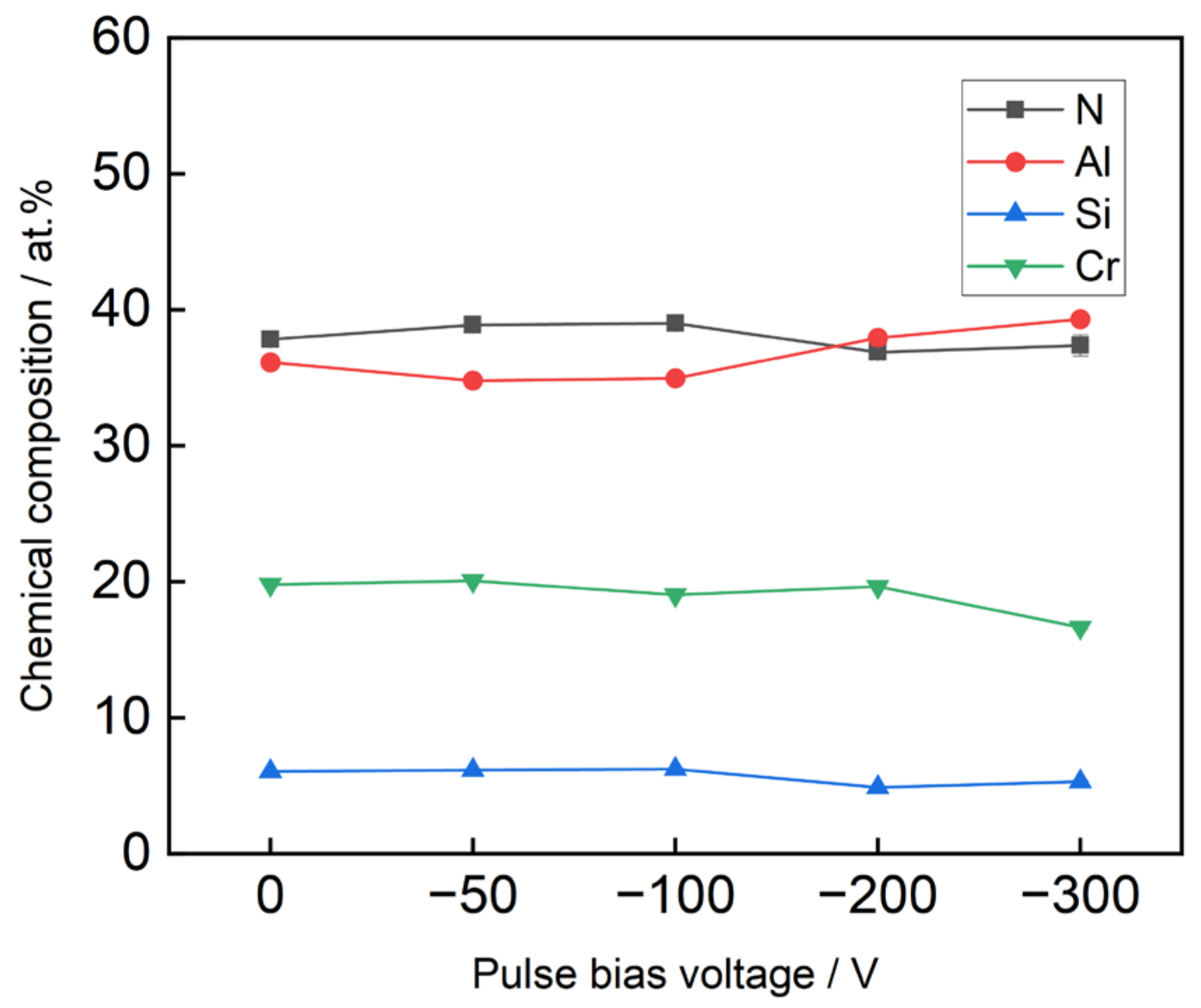
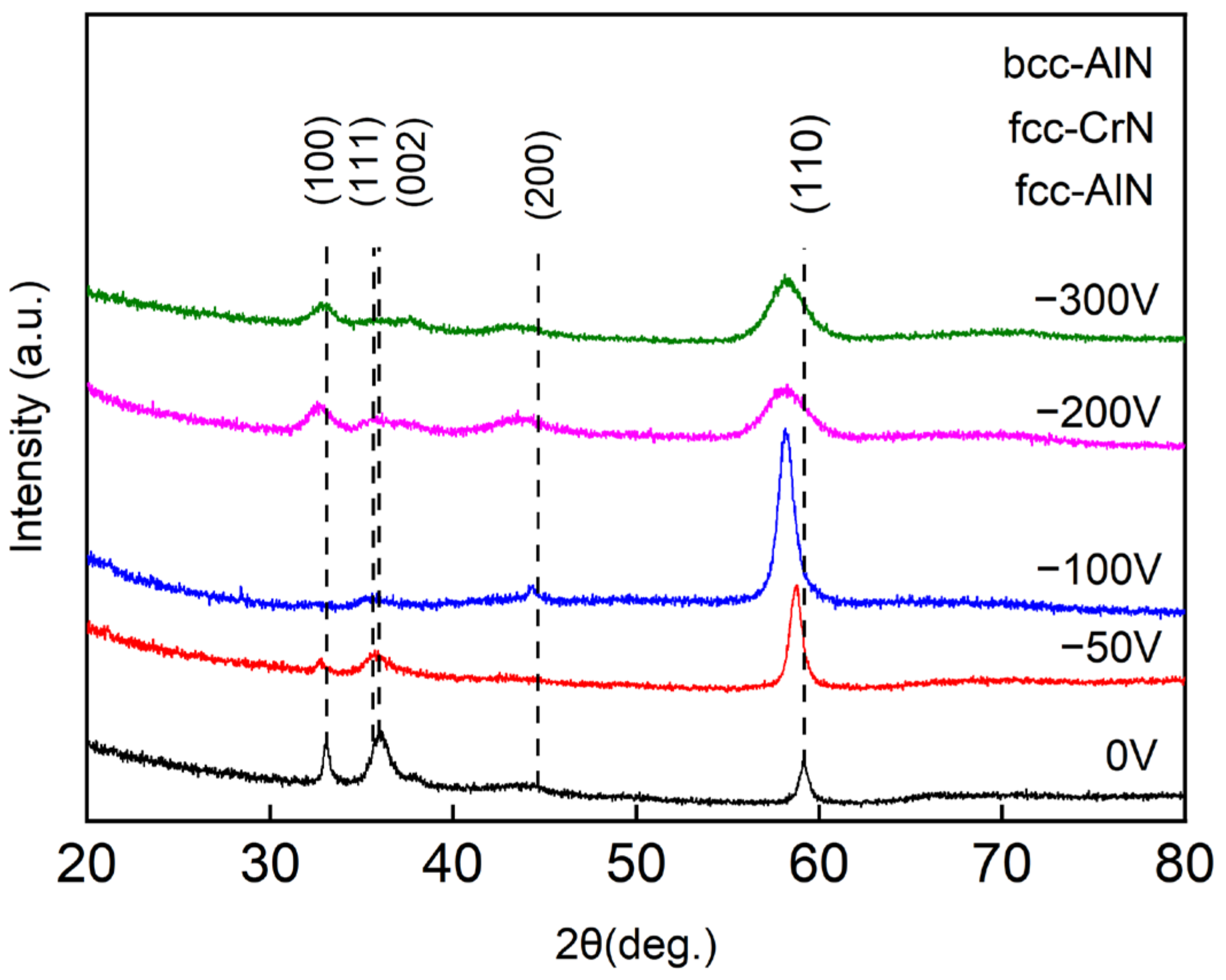
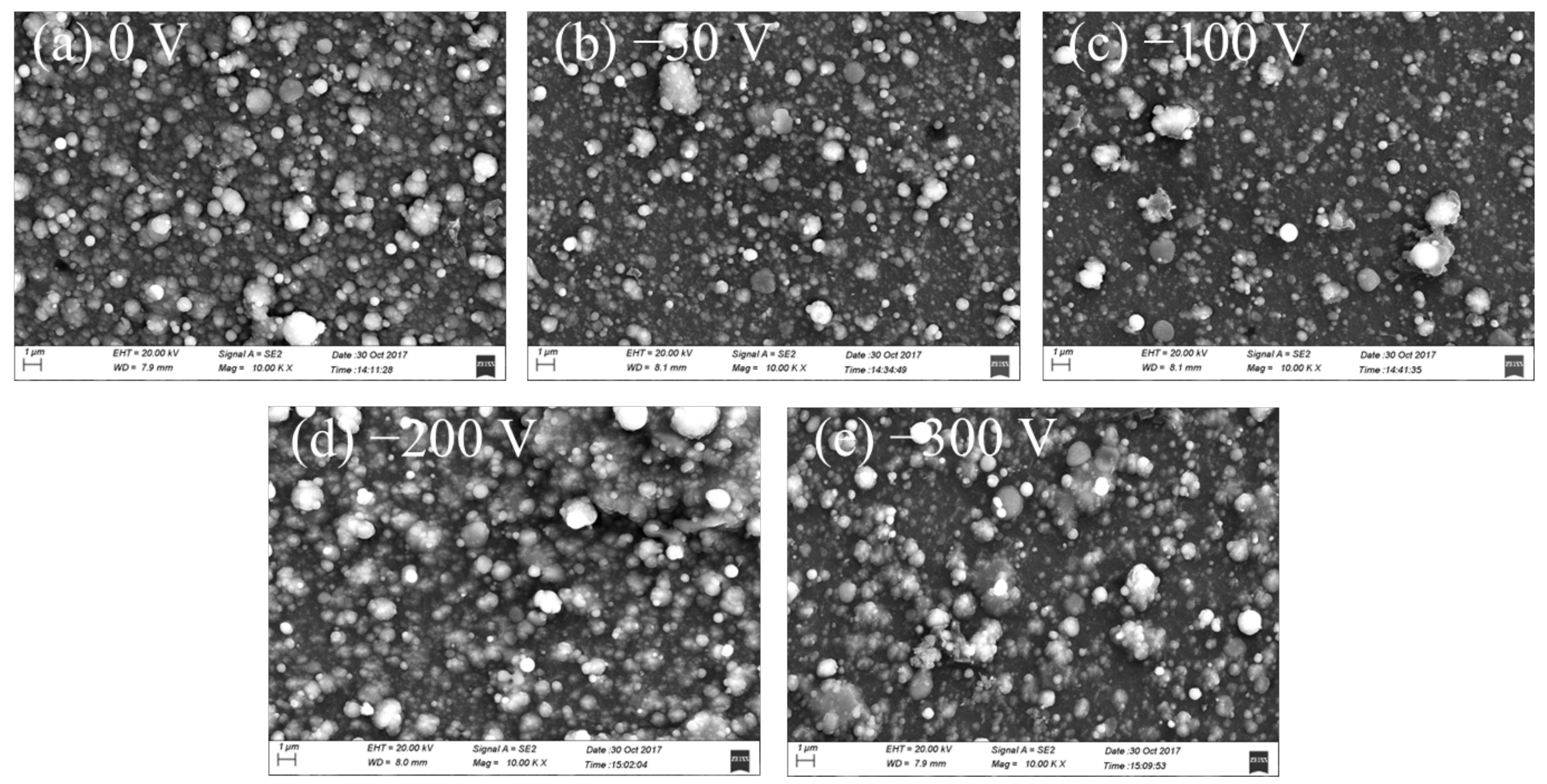
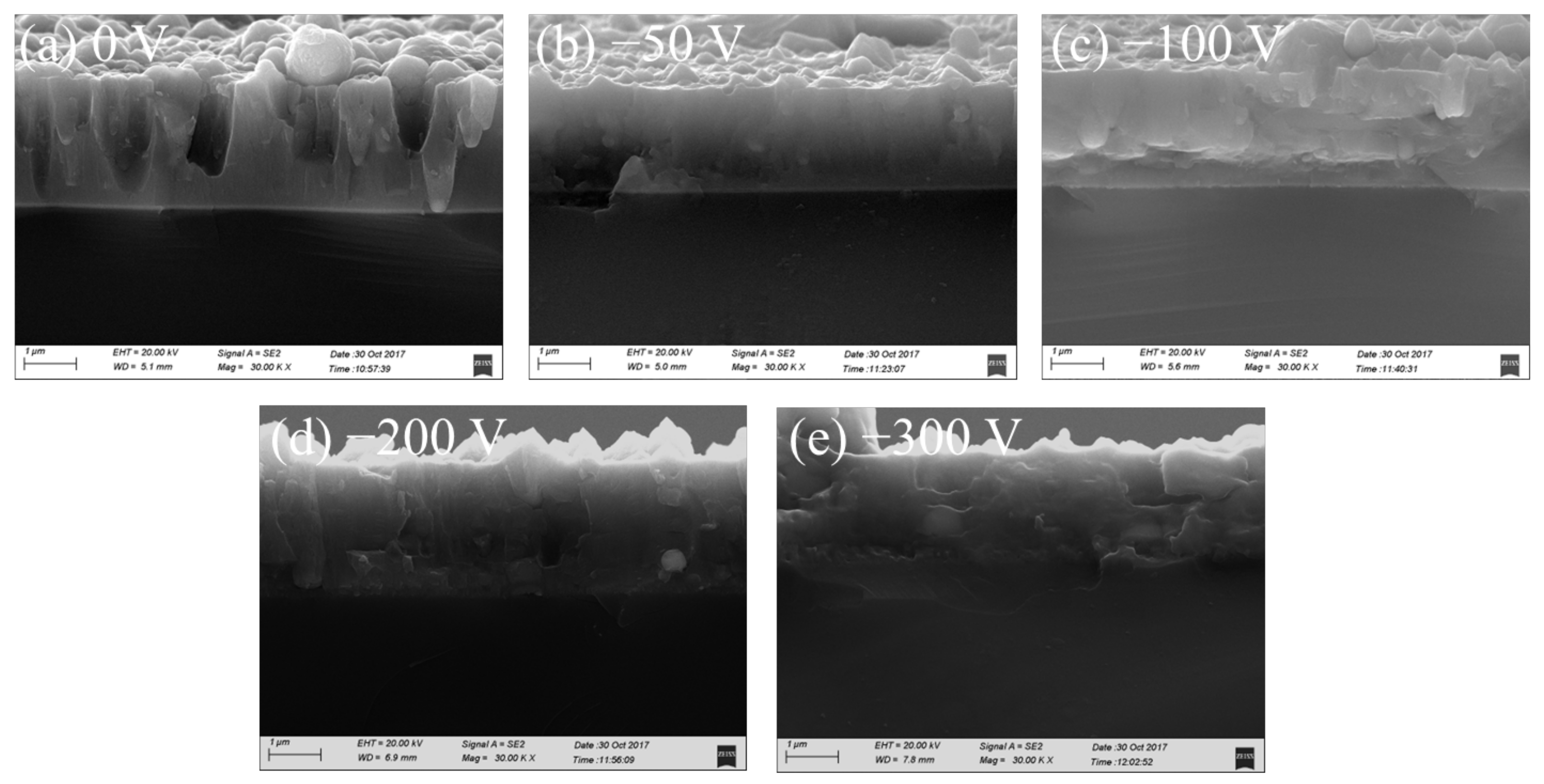
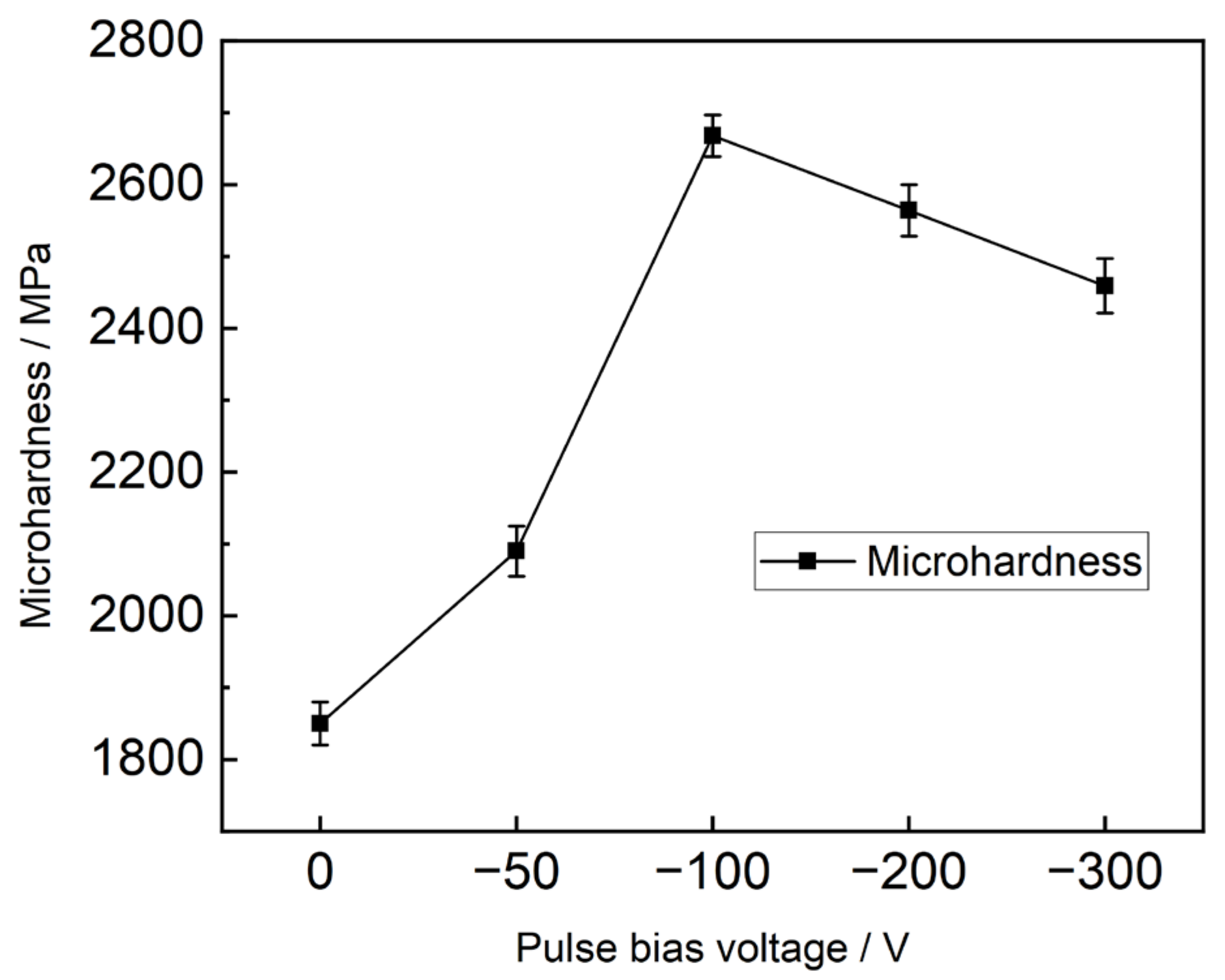

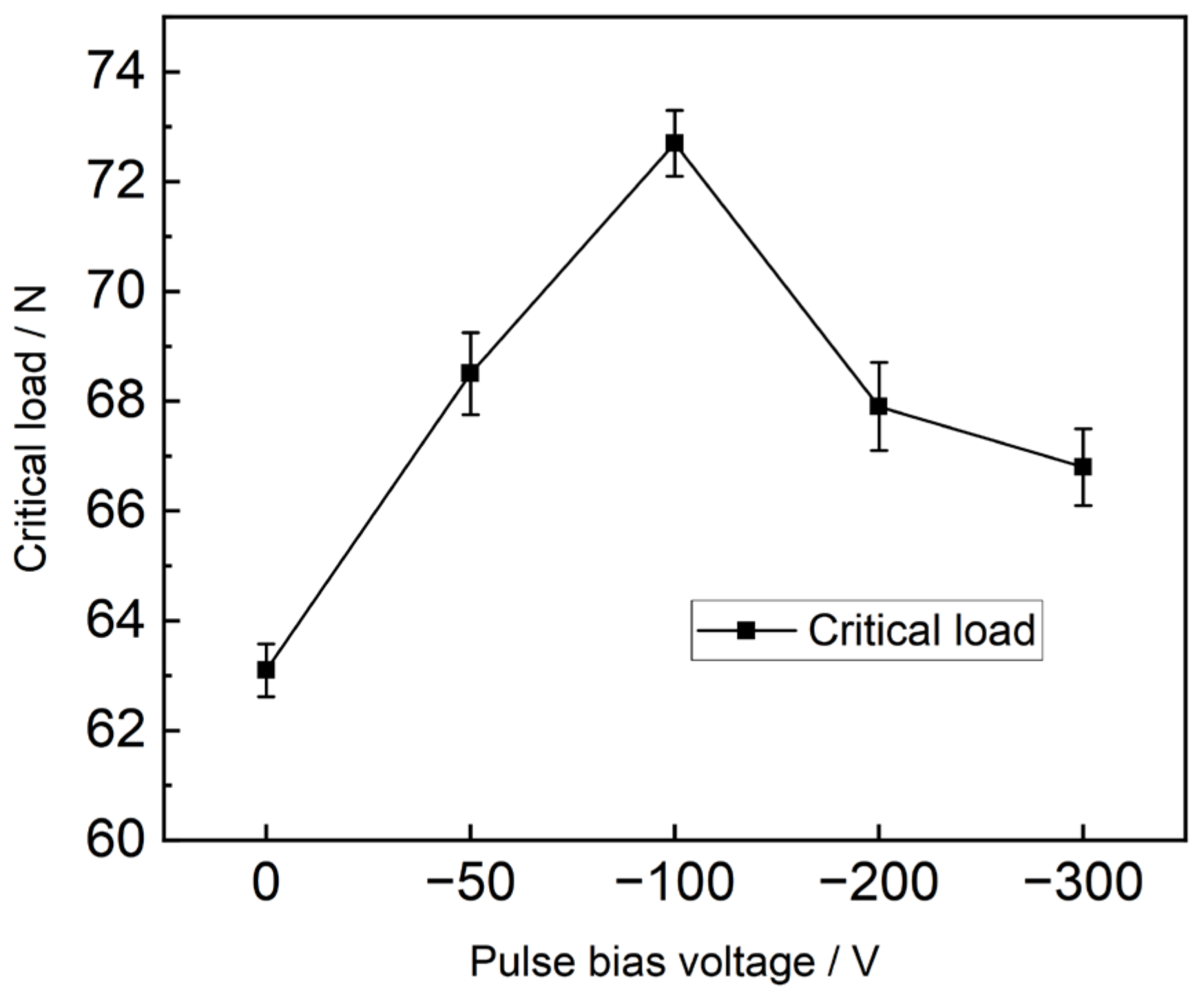

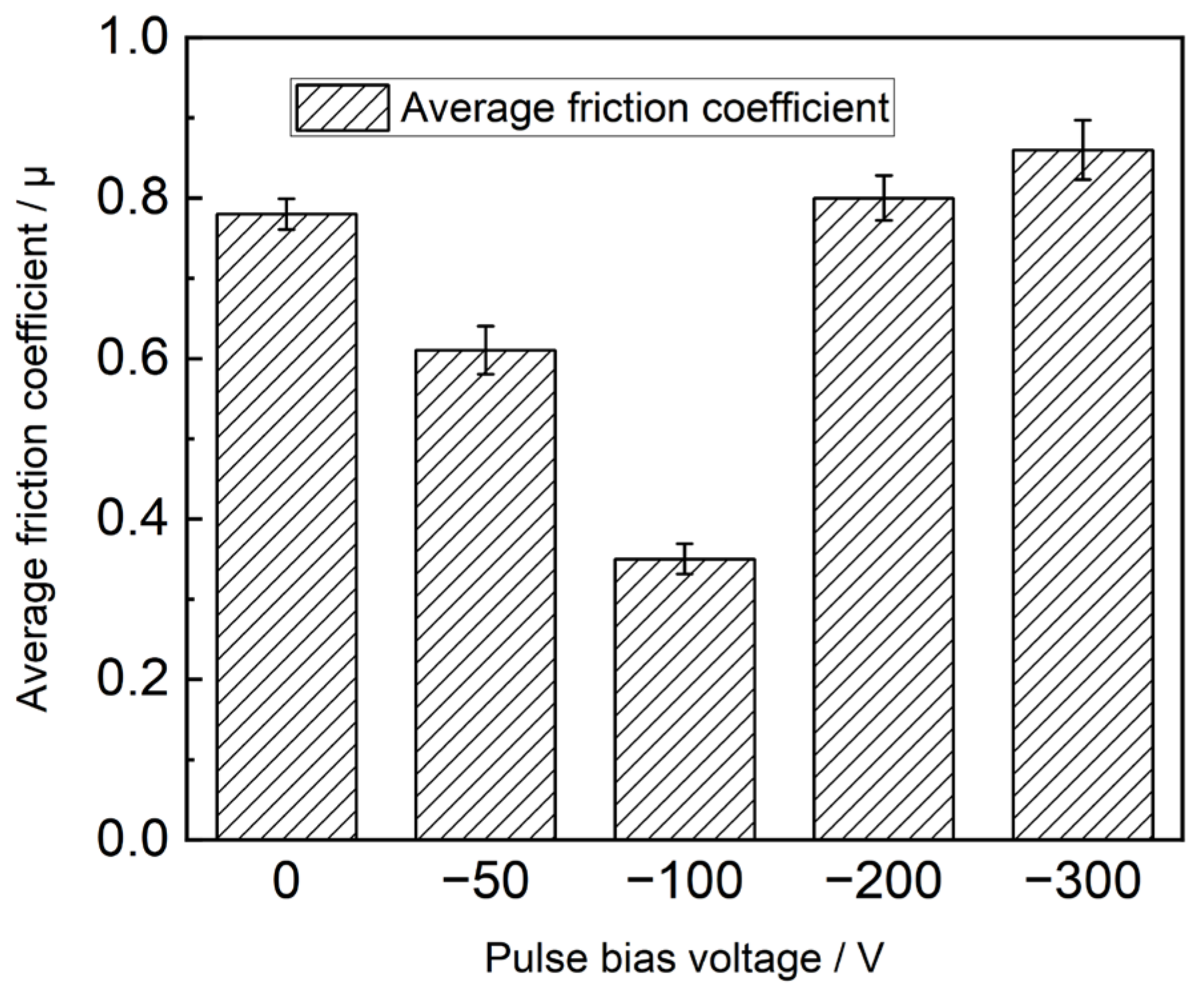

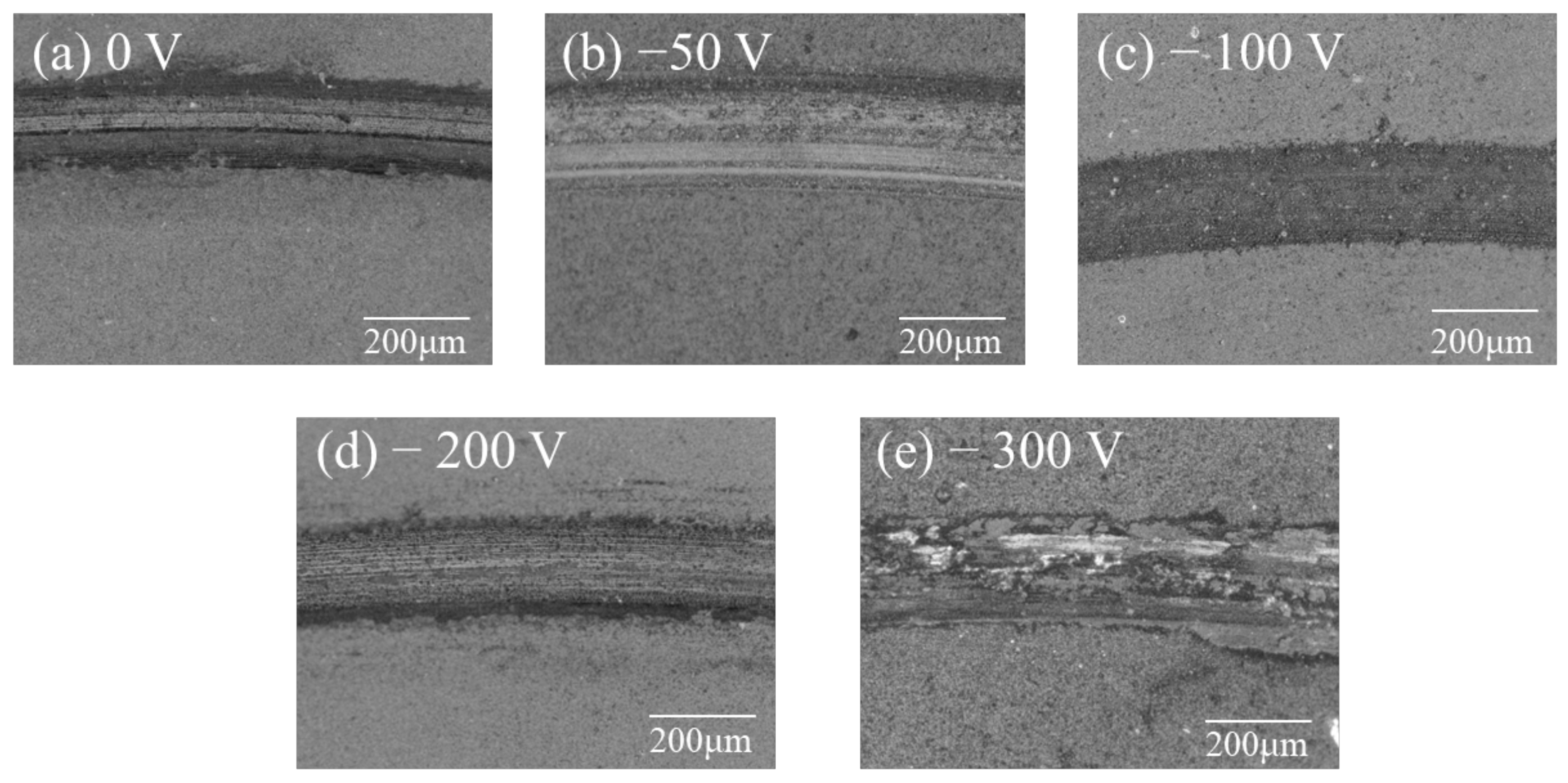
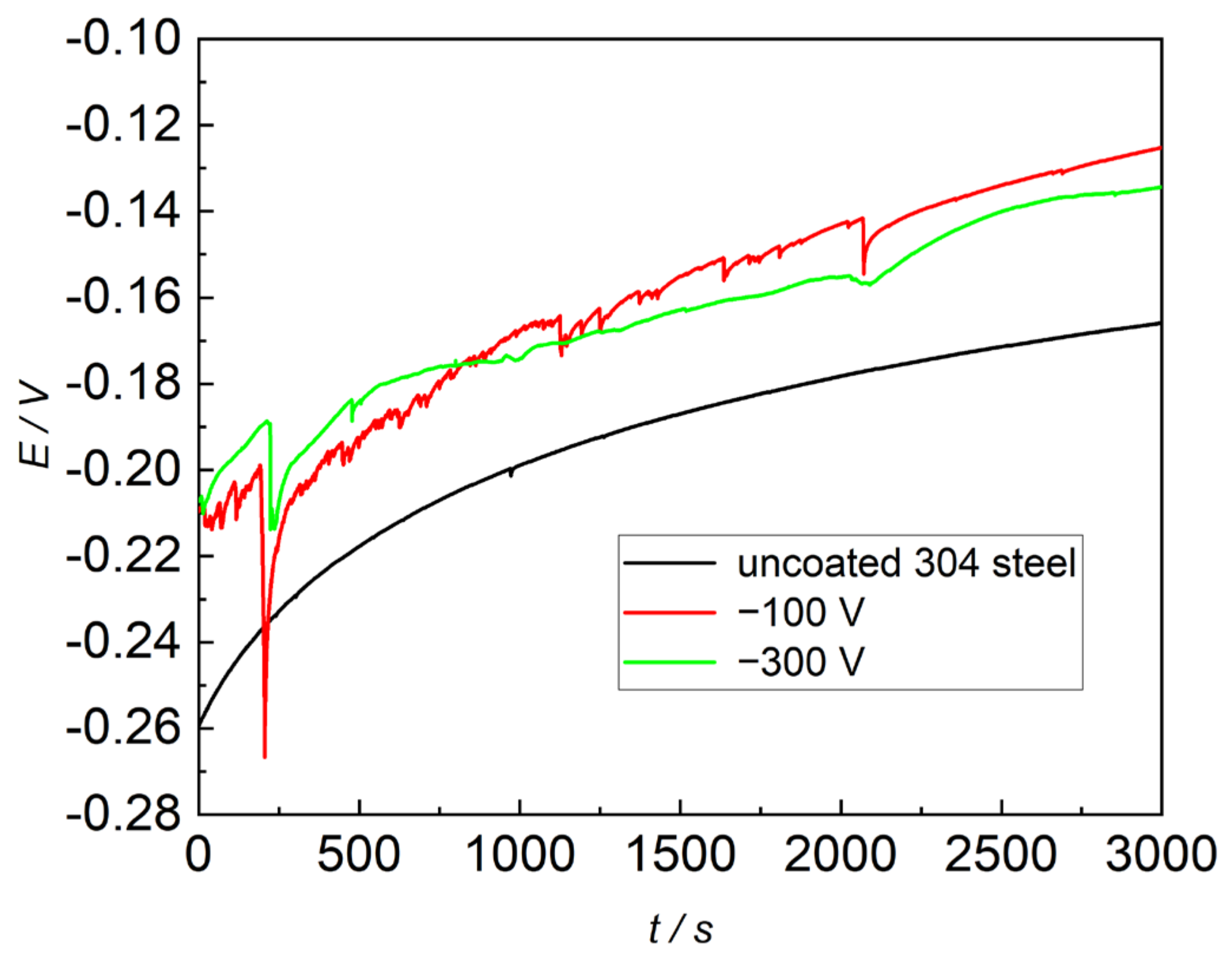
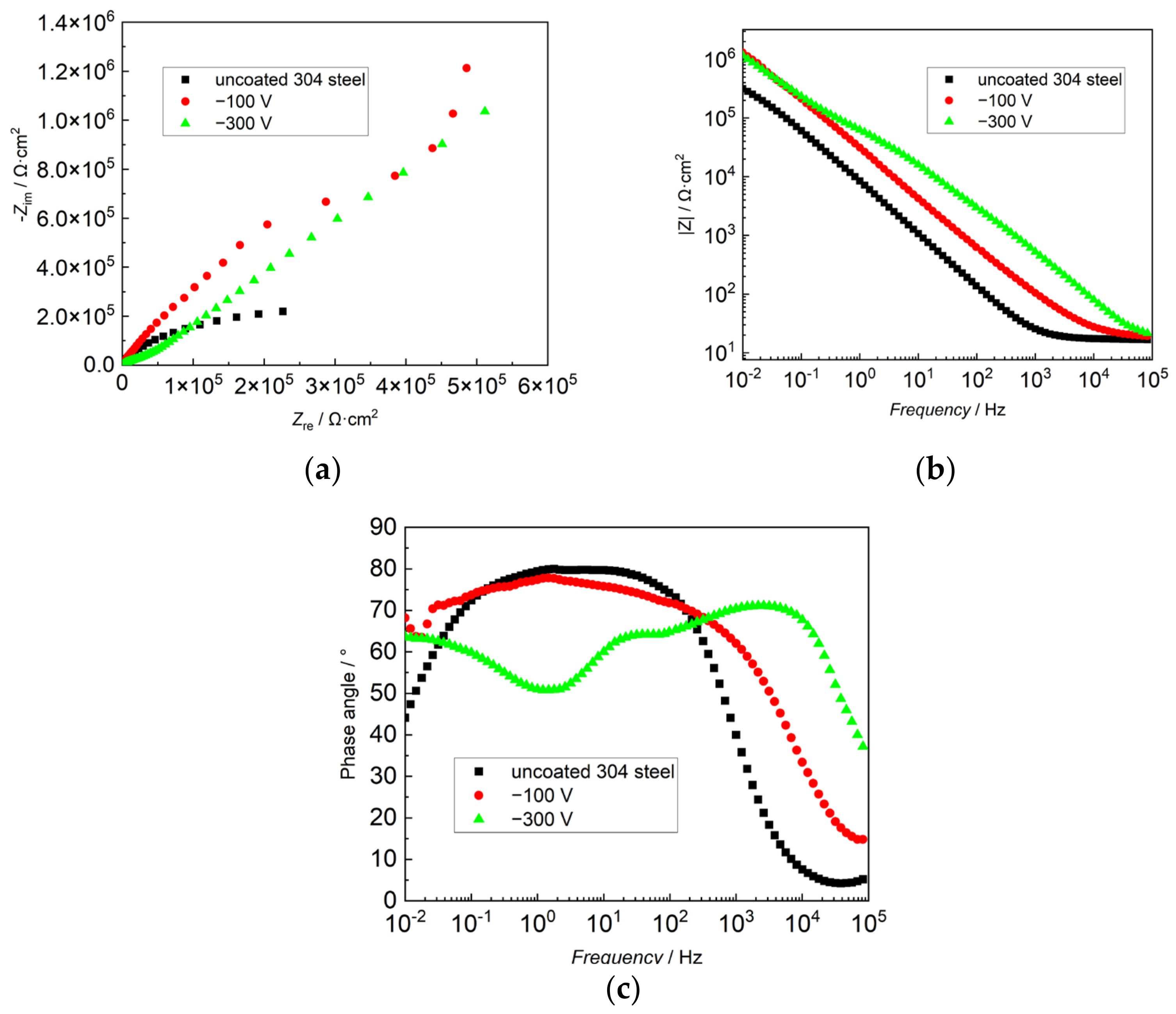
| Parameters | Value |
|---|---|
| Base pressure (Pa) | 3.0 × 10−3 |
| Bias voltage (V) | 0, −50, −100, −200, −300 |
| Deposition temperature (°C) | 300 |
| Deposition pressure (Pa) | 0.6 |
| AlCrSi target current (A) | 90 |
| Ar/N2 flow ratio (mL/min) | 3/16(Ar:30, N2:160) |
| Rotation speed (Hz) | 30 |
Disclaimer/Publisher’s Note: The statements, opinions and data contained in all publications are solely those of the individual author(s) and contributor(s) and not of MDPI and/or the editor(s). MDPI and/or the editor(s) disclaim responsibility for any injury to people or property resulting from any ideas, methods, instructions or products referred to in the content. |
© 2023 by the authors. Licensee MDPI, Basel, Switzerland. This article is an open access article distributed under the terms and conditions of the Creative Commons Attribution (CC BY) license (https://creativecommons.org/licenses/by/4.0/).
Share and Cite
Zhang, R.; Liu, Y.; Wang, C.; Cao, F.; Fan, Q.; Wang, T. Structure and Properties of Arc Ion Plating Deposited AlCrSiN Coatings Controlled by Pulsed Bias Voltage. Metals 2023, 13, 1448. https://doi.org/10.3390/met13081448
Zhang R, Liu Y, Wang C, Cao F, Fan Q, Wang T. Structure and Properties of Arc Ion Plating Deposited AlCrSiN Coatings Controlled by Pulsed Bias Voltage. Metals. 2023; 13(8):1448. https://doi.org/10.3390/met13081448
Chicago/Turabian StyleZhang, Rui, Yanmei Liu, Chongyang Wang, Fengting Cao, Qixiang Fan, and Tiegang Wang. 2023. "Structure and Properties of Arc Ion Plating Deposited AlCrSiN Coatings Controlled by Pulsed Bias Voltage" Metals 13, no. 8: 1448. https://doi.org/10.3390/met13081448
APA StyleZhang, R., Liu, Y., Wang, C., Cao, F., Fan, Q., & Wang, T. (2023). Structure and Properties of Arc Ion Plating Deposited AlCrSiN Coatings Controlled by Pulsed Bias Voltage. Metals, 13(8), 1448. https://doi.org/10.3390/met13081448







